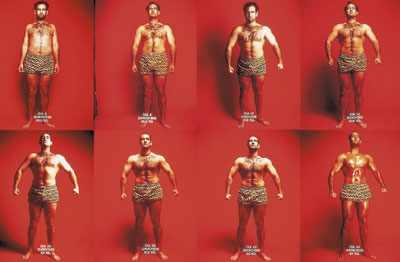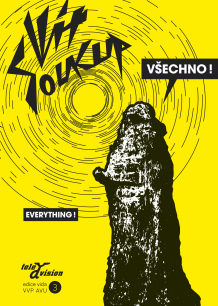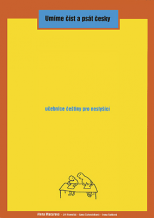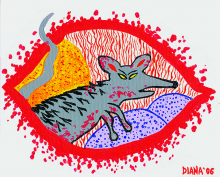| Umělec 2007/4 >> HECTOR FALCON, A PLASTIC MASCULINITY? | Просмотр всех номеров | ||||||||||||
|
|||||||||||||
HECTOR FALCON, A PLASTIC MASCULINITY?Umělec 2007/401.04.2007 Irving Domínguez | muscularity | en cs de es |
|||||||||||||
|
RESONANCES FROM 49: ALTERED METABOLISM
People where / I come from / they survive without feelings or blood / I never could / was stoned to death / but I'm still living Morrissey, He cried In a previous article (Dominguez: 2005) I analyzed the photographic documentation of the performance 49: Altered Metabolism by Hector Falcon 1. The project, whose components dealt with various aspects of the cultural landscape of Mexico’s journalism, fascinated audiences in 2000 and 20012. Aside from the photographic record of 49: Altered Metabolism, the artist found his own ways to document the performance. Falcon created a series of paintings, graphic works, and sculptures that complemented the drawings and diary-log book that were kept throughout the course of the project. My choice to focus on the photographic registry of 49 was not a casual one. The 49 photographs garnered the most attention as they were able to realistically capture the vertiginous muscular development of the artist: it was these images that served as a testimony to Falcon’s drastic physical transformation. 49: Altered Metabolism was conceived as a critical exercise that would challenge the ideologies behind corporal beauty in the western world. It was intended to confront the representations of youth and physical performance which, today, saturate all fields of communication and popular culture. However, the project never achieved its objective: in spite of Hector Falcon’s radical transformation (which was presented as part of the artwork itself), the other avenues through which the change was achieved and represented were ineffective for questioning the stereotypes related to physical beauty. For example, the sculpture series depicting the visible physiological changes that took place in some of Falcon’s organs became more about abstraction—a euphemism of its collateral effects. In these sculptures, which brought to life the internalized process of Falcon’s experience, the audience was able to witness and share in Falcon’s anguish. “It turned out to be heavier than I thought—transforming my body in seven weeks by consuming steroids, performing aerobic exercises and body building, undergoing a military diet and documenting every step through photographs, newspapers and video3...I was left without any money and with a fucking depression.” “Shit! Am I going to live? For how long? All the questions a human being thinks about during the course of a lifetime were on my mind. Was I scared? All the time. Every moment I was more and more afraid, every night I was afraid.” (Lopez: 2000, 1) “I knew about the risks. I took a couple of drugs against cancer: A ball grew in my buttock and it’s not going away.” (Mac Masters: 2001, 1) 49: Altered Metabolism was an organic process that underwent many physical and perceptual changes throughout the course of its development. Falcon’s process affected both the immediate context of his personal relationships as well as his connection to a public audience who sustained an interest in watching his transformation. Hector Falcon experienced a distinct shift in the way he was treated and how his character was perceived in public. The psychological and emotional toll was apparent even to Falcon’s collaborators and friends. The artist found that the attention the “athlete” was paid outweighed the interest people expressed in an “artist.” In several conversations I had with Falcon when I first wrote about 49: Altered Metabolism, he shared with me some of the reactions provoked by his new physical appearance: these responses ranged from sexual harassment, including several payment offers, while other men pressured him to reveal where he had obtained the illegal substances as they hoped to use the drugs to emulate his spectacular results. For Falcon the response that his transformation elicited made evident the failure of his proposal. In my opinion this type of response merely highlights a particular truth about society: the relation of a muscular and toned appearance to a definition of contemporary masculine identity is undeniable (Drummond: 2003). The appearance of muscles is associated with the practice of weightlifting—a sports activity that allows men (sportsmen or not) to articulate a pragmatic, performative and misogynous discourse. That is to say, weightlifting “liberates” those who practice it of feminine characteristics or attributes (Dominguez: 2005, 2). While the artist may not subscribe to the ideological significance of this form of physical exercise, his incursion into the social sphere of the weight-lifters allowed him to appropriate its visual rhetoric; a rhetoric designed to feed a certain fantasy that the male body cannot be penetrated (Ian: 1996). According to Murray Drummond, achieving the desired muscle tone and the lowest percentage of body fat is the par-excellence goal of the contemporary male. For the modern man this goal is fueled by a desire to compare to the idealized male body seen in advertisements. In this formula it is clear that masculinity is established through visual cues: masculinity is equated with muscles and an overall domineering appearance. The photographs of 49: Altered Metabolism serve as a chart by which to read this process as it takes place on the site of Hector Falcon’s body; he becomes a man, according to theories such as Drummond’s. In the photographs no signs of pain or indications of fatigue are allowed to be displayed. Each one of the images dramatizes the current state of Falcon’s body and forces the viewer to recognize the striking muscular development over time. The group of pictures, read together, oscillates between notions of corporal change and the transparency of the process. During the performance the red stage, whose tone referred to the color and texture of blood, relentlessly captured the audience’s gaze, amplifying Falcon’s physical effort and strain. In the series of pictures the artist is photographed wearing a pair of boxers that prevent any definition of his buttocks or genitals. In some shots his biceps are tightly contracted, in others his arms are relaxed. The panels devoted to the biceps present Hector Falcon fascinated by the solidity and strength of his own body. Conversely, in the photos of Falcon’s back he seems to have abandoned this personal examination and left his body to the spectator’s scrutiny. Read together the images multiply and intensify the significance of the body, succinctly summarizing its hasty transformation. Mauricio Alejo, better known for taking abstract pictures that explore the relationship between objects, light, and form, was chosen to take all of the photographs for 49. Alejo’s talent may have been specifically sought out as it seems Hector Falcon wanted to be represented as an object, a phallic object (4). Hairless, erect, with all his muscles perfectly delineated, Hector Falcon presents himself as a threatening being; as if he could attack us but instead he is smug and satisfied with the ability to merely suggest this possibility. With this statement Falcon hypothesizes that every virile man’s mission in life is to appear strong and invincible, without having to actually prove anything. The condition of contemporary masculinity, as understood by Cornell, is that the masculine being (body) offers the only means by which to become masculine, a privilege reserved for workers, heavy machinery operators, members of security or rescue organizations and athletes, of course (Cornell: 1983, quoted by Drummond). These characterizations of virility as a constant obsession build upon Judith Butler’s theories about gender identities: “Gender must not be interpreted as a stable identity or a place where the capacity for action sits and from which different actions come, but instead, as a weakly constituted identity in time, established in an outer space by the stylized repetition of acts. The gender effect is produced by the stylization of the body and, therefore, it has to be understood as the worldly way in which all the different kinds of gestures and body styles constitute the illusion of a being with a constant gender.” (Butler: 2001, 171 and 172) Hector Falcon’s performance as an athlete and the ensuing dissonance that it provoked with regard to his public condition as an artist reveals such instability to be true. In 49 Falcon exercised his ability to transition from one manifestation of his body to another—one more obviously associated with the ideals of masculinity as outlined above. During his brief embodiment of this “masculine” state, Falcon may have abandoned rational/subjective processes in favor of obtaining tangible results like immediately receiving attention from other males. It cannot be denied that in certain daily spaces Falcon’s recently obtained masculinity would have not only practical applications but also symbolic and political significance and power (see Bourdieu: 2000, 45 – 54). Ultimately though, Hector Falcon decided to return to the masculine experience tied to his life as an artist before 49: Altered Metabolism. From a pragmatic standpoint, Falcon’s return to his former appearance is a political suicide: he forfeits the possibility of using his stereotypically masculine condition as a coercion tool to subvert the dominant representations of gender. However, Falcon’s extreme 49 transformation was but one example of his habit of manipulating his physical appearance as a means to heighten and alter his social experience. In his years as a college student Falcon strutted the catwalk and posed for photographers while working as a professional model. Therefore it can be said that Hector already knew a thing or two about the issues related to the beauty corporation where one is always measured against rather homogenous and, some may say, unrealistic, standards. In these spheres physical beauty is always measurable as it is read visually in the body. The modeling world recognized in Hector Falcon someone who could easily be modified, sharpened, revised in accordance with the whims of fashion demands. For 49, Falcon chose to adapt his ability to physically transform for his own extreme ends. The transition through different aesthetic modes of masculinity: from professional model to visual artist, then to bodybuilder and eventually returning to the condition of artist, has enabled Hector Falcon to experience a wide range of societal vantage points. Seven years after 49: Altered Metabolism, Falcon has maintained a strong interest in both arbitrary and absurd body modifying techniques. Falcon’s series Vital Registries (2001- 2003), which can be considered an extension of the aforementioned performance, consisted of a set of actions that “detoured” regular practices of personal hygiene. During this period he avoided shaving and getting his haircut. Along with these small alterations to daily habits Falcon also began enlisting more and more aggressive body altering techniques such as getting tattoos or a tan. He experimented with tanning to the point of brandishing the inside of his left arm with a red hot iron bar (Pain). Falcon has chosen these particular manipulations, some ephemeral and others permanent, as they are associated with beauty practices in Western culture. It is no coincidence that all of Hector Falcon’s shows between 2002 and 2006 had his name as the title, since his body continues to be the site for his work. Falcon has also managed, in these commentaries about revising and investigating the idea of beauty, to integrate ideas about the female body. He has done some work where, in an attempt to subvert the idealization espoused by the cosmetic enhancement market, participants are forced to remain completely still for a certain period of time—they become ephemeral sculptures, while also bearing testimony to the physical imprisonment of the female body and its “accessories of femininity” which are altered in an attempt to draw a certain type of attention. Link (Japan, 2002) beautifully demonstrates this idea of entrapment and connectedness as a group of female Japanese students agreed to unite their bodies and create a human chain by linking their piercings with a single strand of jewelry. For Eleganza (Mexico City, 2003) the artist recruited professional models who were willing to be attached to one another by special fake nails designed specifically for the piece. In this installation it is more than the physical imposition of the distorted cosmetic enhancement which is at work—the performance is also about engaging with an audience. While other artists like Vanessa Beecroft enlist participants in their performances, Hector Falcon’s finely orchestrated works are about allowing the human body to be exposed in front of an often skeptical, sometimes irresponsible audience. When one decides to “beautify” himself is physical vulnerability unavoidable? During the transformative process do changes concerning gender identity automatically occur? Is it a reversible or permanent alteration? Do medical processes related to plastic surgery contain the solutions to these discomforts? In his 2006 solo exhibition presented by the Enrique Guerrero Gallery in Mexico City, Hector Falcon gathered together and displayed a group of visual aids which sought to show the newest ways to clinically diagnose disease and utilize new medical technologies. The subject is explored in 2-D as well as 3-D representations that reveal how fragile and fragmentary the construction of the individual identity is once it is dissected by medicine. The work serves to break apart the body’s physicality and the images appear abstract except to an elite group of medical professionals who possess the ability to read these images and use them to understand the functions of the human body. In Breath (2006) a topographical sculpture reproduces the moment when Falcon inflates his cheeks by holding air in his mouth. The 3-D cast that freezes this brief and seemingly unimportant moment magnifies the minute physical process and makes one consider its significance in new ways. While Breath focuses on a conscious action, the photograph entitled Waiting (2006) shows the face of an anesthesia-induced patient who lazily daydreams as they await facial surgery. The rest of the exposition, especially the cluster of silicone breast implants and Falcon’s own fat which was extracted and used to spell the word Self on a piece of wood, make it impossible to ignore the physical toll of surgeries aimed at cosmetic enhancement. Orlan’s work is an obligatory reference in any discussion of Falcon’s projects, however gender is an axes of separation between the two artists. The male artist seems preoccupied, if not obsessed, with his virility and the way he is represented. Isn’t masculinity an unrelenting pursuit through which a man tries to demonstrate his own infallibility? Isn’t failure one of the determining factors of virility, that is to say, isn’t the most important thing to overcome the error and to triumph over it? What for? Until when? “This you see, a colorful deceit, (…) / is a cautious deceit of the senses; (…)” as our beloved Sor Juana Ines de la Cruz would say. In the Historical Center of Mexico City, May the 11th of 2007, year of the “Chilango” unveiling.
01.04.2007
Рекомендуемые статьи
|
|||||||||||||
|
04.02.2020 10:17
Letošní 50. ročník Art Basel přilákal celkem 93 000 návštěvníků a sběratelů z 80 zemí světa. 290 prémiových galerií představilo umělecká díla od počátku 20. století až po současnost. Hlavní sektor přehlídky, tradičně v prvním patře výstavního prostoru, představil 232 předních galerií z celého světa nabízející umění nejvyšší kvality. Veletrh ukázal vzestupný trend prodeje prostřednictvím galerií jak soukromým sbírkám, tak i institucím. Kromě hlavního veletrhu stály za návštěvu i ty přidružené: Volta, Liste a Photo Basel, k tomu doprovodné programy a výstavy v místních institucích, které kvalitou daleko přesahují hranice města tj. Kunsthalle Basel, Kunstmuseum, Tinguely muzeum nebo Fondation Beyeler.
|

































 New book by I.M.Jirous in English at our online bookshop.
New book by I.M.Jirous in English at our online bookshop.
Комментарии
Статья не была прокомментированаДобавить новый комментарий